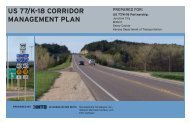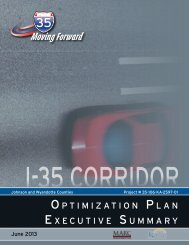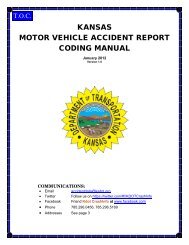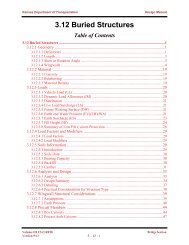Full Plan - Kansas Department of Transportation
Full Plan - Kansas Department of Transportation
Full Plan - Kansas Department of Transportation
Create successful ePaper yourself
Turn your PDF publications into a flip-book with our unique Google optimized e-Paper software.
<strong>of</strong> upgrading to digital equipment and interfaces with WAN and mobile devices to 6<br />
district <strong>of</strong>fices.<br />
The Paranet report the following steps for KDOT:<br />
• Implement VPN (virtual private network) for locally and remotely securing data<br />
communications to all 6 district <strong>of</strong>fices<br />
• Use the 800 MHz network as voice and data channel support, and AVL backbone<br />
• Use microwave's large capacity infrastructure backbone for data transfer. Continue<br />
the migration to digital equipment<br />
• Introduce wireless WAN (wide area network)<br />
• Use ISDN (integrated services digital line) for redundancy to VPN<br />
• Take advantage <strong>of</strong> Sprint's integrated, on-demand network (ION). Currently, Sprint<br />
ION is being beta-tested in <strong>Kansas</strong> City at Hallmark<br />
The Sprint Paranet Study suggests that the existing and proposed telecommunications<br />
infrastructure would be used to enhance the voice, video and data connectivity to all<br />
KDOT <strong>of</strong>fices. This infrastructure would benefit those using mobile data, the traveling<br />
public, and all external entities.<br />
KDOT has several options to pursue in order to maximize the existing infrastructure.<br />
Currently, KDOT utilizes a minimum committed information rate (CIR) frame relay<br />
connection <strong>of</strong> 384k connection from the main <strong>of</strong>fices in Topeka to the field <strong>of</strong>fices.<br />
Should infrastructure be available, KDOT could increase the CIR <strong>of</strong> their frame relay<br />
connections from 384k to 756k. Regardless <strong>of</strong> the circuit type, the CIR will not exceed<br />
1.0 Mbps. Additionally, KDOT could continue to replace its analog microwave<br />
equipment with digital equipment. Both <strong>of</strong> these options would increase the speed and/or<br />
bandwidth at which communications can be processed.<br />
1.1.4 K-10 Smart Corridor<br />
The K-10 Corridor will provide enhanced telecommunications and Information<br />
Technology (IT) services to the public through the work <strong>of</strong> a consortium <strong>of</strong> government,<br />
education, and private entities. When completed, the building blocks will be in place to<br />
provide ISDN, T-1 (1.544 Mbps) lines, asymmetric digital subscriber lines, and number<br />
portability at competitive, reduced rates. This Smart Corridor will also create new<br />
opportunities for telecommunications partnerships and competitive services for all units<br />
<strong>of</strong> local government, educational institutions, private firms, and citizens located within<br />
the K-10 Corridor's communities. These communities include Lawrence, Eudora,<br />
DeSoto, Olathe, Lenexa, Shawnee, Overland Park, Leawood, and <strong>Kansas</strong> City. The K-10<br />
Smart Corridor will be a fiber optic based network.<br />
As a consortium <strong>of</strong> local government, educational institutions, and private firms, the<br />
Smart Corridor members will have the clout to negotiate with telecommunications<br />
service providers to get better prices for more bandwidth. Obviously, this Smart Corridor<br />
Baseline Condition Report 1-7<br />
Section 1 <strong>of</strong> the <strong>Kansas</strong> Statewide ITS <strong>Plan</strong><br />
July, 00

















